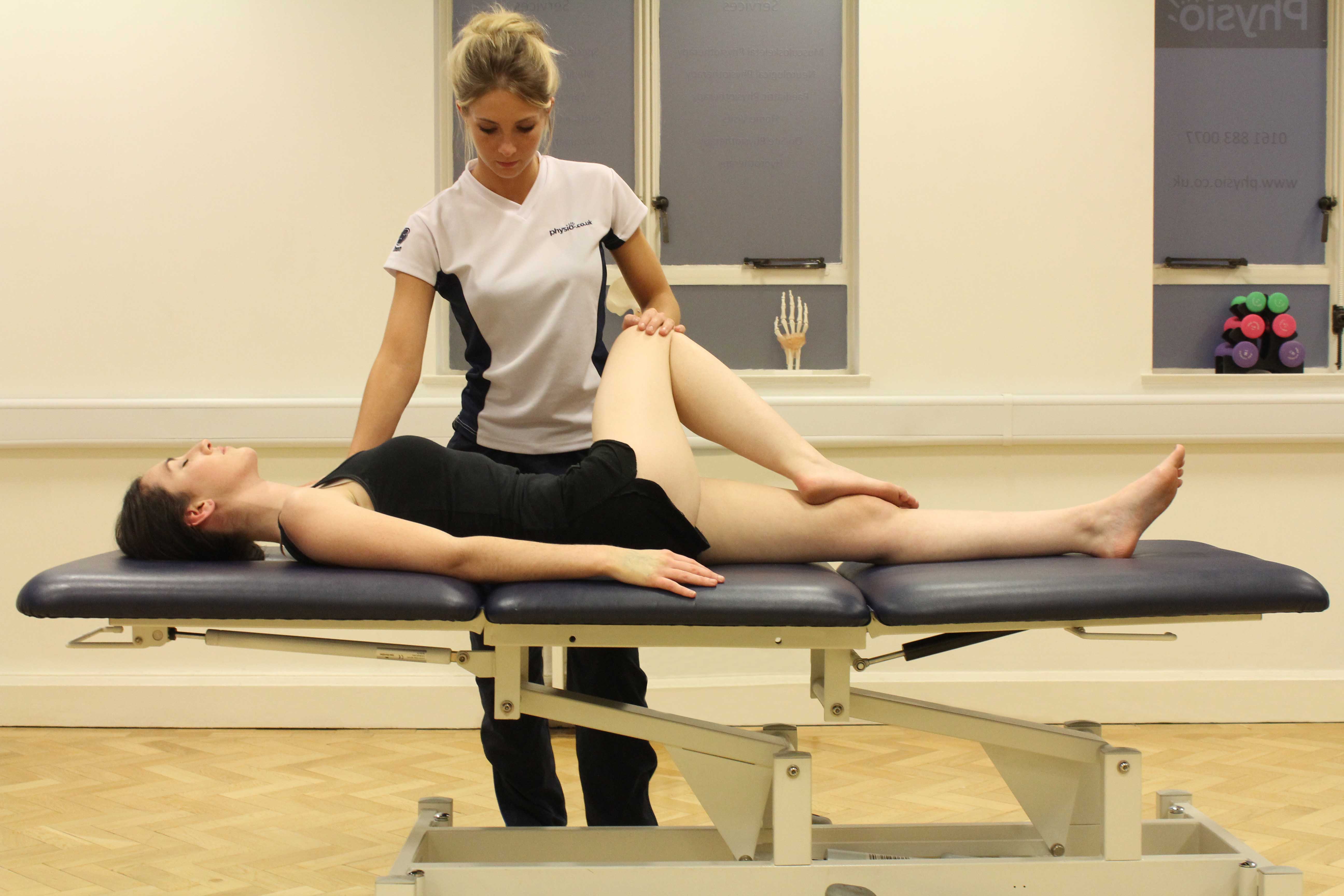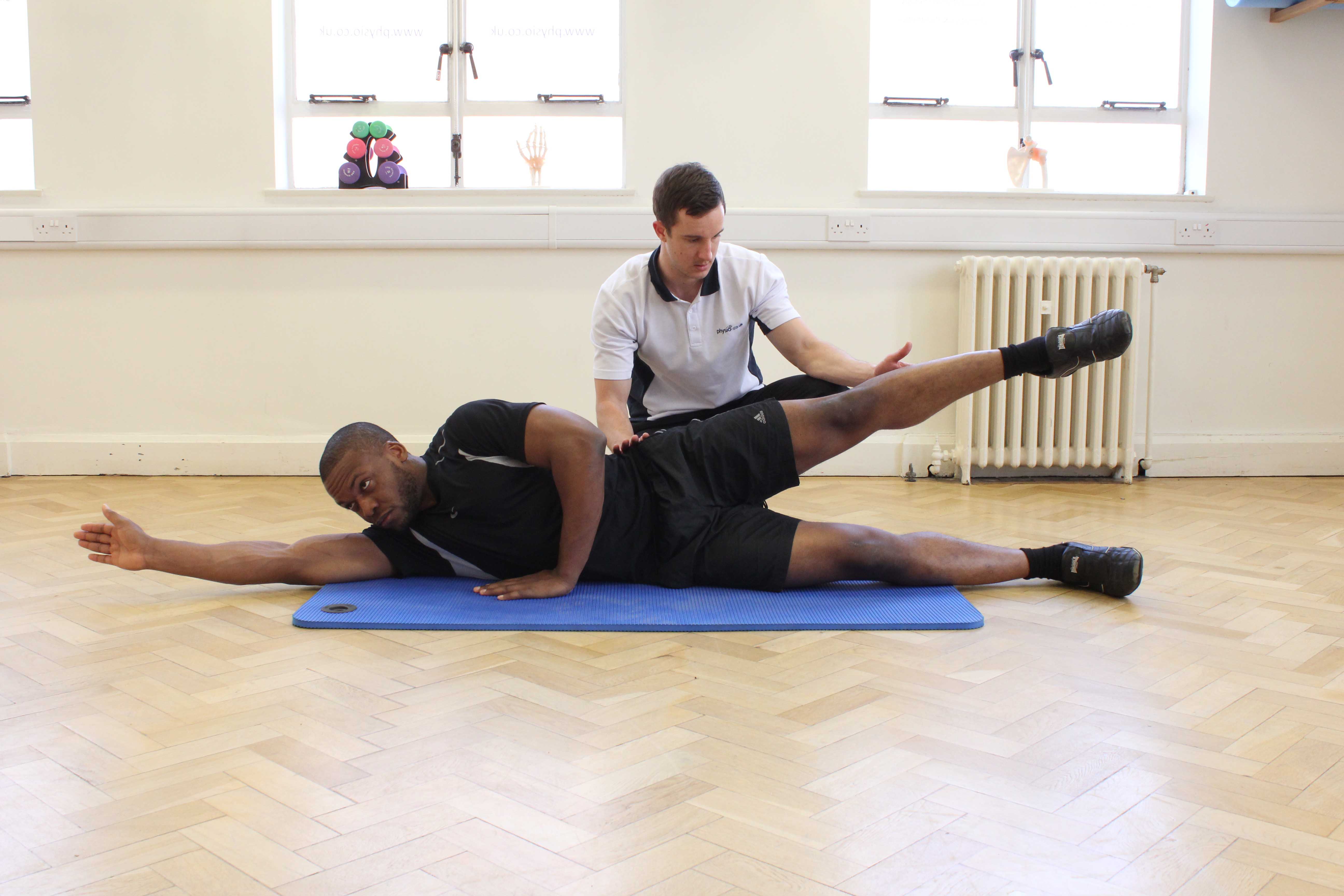What is a stress fracture of the neck of the femur?
The neck of the femur is the top of your thighbone (femur) where it angles into your hip socket. A stress fracture of the neck of the femur is a crack in the thigh bone at this point. Physiotherapy is an excellent treatment for a stress fracture of the neck of femur.
 Above: Passive stretch of the muscles and connective tissues of the hip by specialist therapist
Above: Passive stretch of the muscles and connective tissues of the hip by specialist therapistHow does a stress fracture of the neck of the femur happen?
Stress fractures of the neck of the femur result from an imbalance between bone formation and bone resorption. When the neck of the femur is loaded or stressed, such as during weight-bearing exercise, it responds by increasing its bone turnover. This is necessary for it to live up to your demands on it. Bone turnover involves the removal of weakened, damaged areas of bone and the laying down of new bone at the same location. To do this, old bone is resorbed (removed) before it is replaced with new bone. If bone formation cannot keep up with bone resorption, areas of weakness can develop within the neck of the femur. These can develop into a stress fracture if the bone is continually loaded.
If stress is put on the neck of the femur, areas of the bone can become damaged. These damaged areas of bone are then resorbed and replaced with new bone. If the new bone formation is slower than the resorption of the old bone, weak areas are caused at areas of stress within the neck of the femur. An area of weakness in the bone can develop into a stress fracture if the weak area of the neck of femur is repeatedly stressed.
 Above: Passive stretch of the muscles and connective tissues of the hip by specialist therapist
Above: Passive stretch of the muscles and connective tissues of the hip by specialist therapistWhat are the symptoms of a stress fracture of the neck of the femur?
A stress fracture of the neck of the femur typically presents as a gradual onset of a dull ache in the groin. This pain is often difficult to localise and in some cases can become so severe that it is present during walking and even at rest. Other symptoms include:
What should I do if I have a stress fracture of the neck of my femur?
If you have or suspect that you have a stress fracture of the neck of your femur, you arrange a physiotherapy assessment as soon as possible.
 Above: Progressive strengthening hip exercises supervised by experienced therapist
Above: Progressive strengthening hip exercises supervised by experienced therapistPhysiotherapy treatment for a stress fracture of the neck of the femur.
The assistance of a physiotherapist is important in the treatment of stress fractures of the neck of the femur. Initially, your physiotherapist can diagnose your injury. Referral for bone, CT or MRI scans may be required to confirm your diagnosis and to ascertain the extent of the damage. Following this, your physiotherapist will devise a treatment plan specifically for you. Initial treatment may involve the use of crutches and anti-inflammatory medication. Other treatments include:
What shouldn’t I do if I have a stress fracture of the neck of my femur?
If you have or suspect that you have a stress fracture of the neck of your femur, you should not continue perform activities that aggravate your pain. A stress fracture is an area of weakness within the bone; therefore, if you continue to exercise, the bone could weaken further. Further weakening can lead to a larger crack in the bone and potentially a complete bone fracture.
 Above: Progressive strengthening hip exercises supervised by experienced therapist
Above: Progressive strengthening hip exercises supervised by experienced therapistCould there be any long-term effects from a stress fracture of the neck of my femur?
Stress fractures of the neck of the femur do not generally produce any long-term effects if the cause is identified and treated appropriately. Without the correct treatment and advice, there is a risk that the crack will increase in size, develop into a complete bone fracture, or further stress fractures when you return to normal activities.
To arrange a physiotherapy assessment call Physio.co.uk on 0330 088 7800 or book online.

 0330 088 7800
0330 088 7800


































